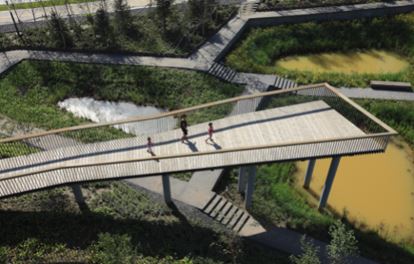Urban runoff can contribute to flooding and abrupt contribution to flow in peri-urban/urban streams. It is also frequently characterized by poor water quality, as runoff might contain a mix of contaminated sediments, pollutants, oils through to feltilizers and pesticides if these are not properly applied. In order to meet such challenges, alternative solutions exist, such as the one specified below.
Constructed Wetlands (CW) are fully engineered systems using natural processes to treat water for household (blackwater or greywater) and/or biodegradable municipal or industrial wastewater, as well as manage runoff. They use wetland vegetation, soils, and their associated microbial assemblages to assist in treating wastewate
CWs can be classified into two variants:
- Subsurface constructed wetland: in this category of CW, the flow of wastewater occurs between the roots of the plants and there is no water surfacing (it is kept below gravel). The subsurface constructed can be classified into two categories:
- vertical subsurface flow constructed wetland: wastewater moves vertically from the planted layer down through the substrate;
- horizontal flow constructed wetland: wastewater moves horizontally via gravity, parallel to the surface. In this case, the wastewater is fed at the inlet and slowly flows horizontally through a porous media in which emergent vegetation is planted.
- Free water surface constructed wetland, that allows water to flow above ground exposed to the atmosphere and to direct sunlight. It creates therefore an open water areas that contain floating, submerged, and emergent plants. This type of CW is usually for tertiary treatment of previously treated water.

Scheme of vertical subsurface flow CW, horizontal subsurface flow CW, and free water. Source: Qunli
In terms of mitigation, constructed wetland have the potential to sequestrate the carbon. However, they need to be designed properly, so as to minimise methane and nitroxid emissions, which will depend on a multitude of factors (type of CW, used plants, flow mode of wastewater, etc.).
In terms of adaptation, constructed wetland allows to reduce moderately the heat urban island, due to the cooling role played by plants and water. Constructed wetland contribute to reduce flood risk, by reducing the volume of water in drainage networks during events.

Stormwater Wetland Park - Turenscape (China). Source: www.archdaily.com
Constructed wetland has also co-benefits in terms of biodiversity and quality of water returned to the environment. Wetland integration in the urban environment requires a good understanding of the hydrological regime, as well as spatial integration as a landscape piece of infrastructure. Once implemented, a constructed wetland will require careful maintenance and management.
Comments ()